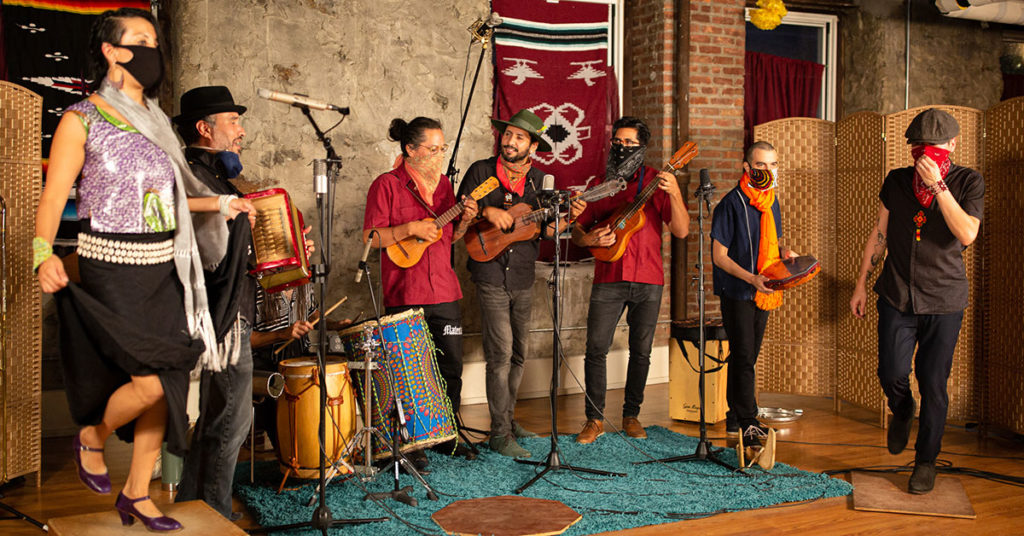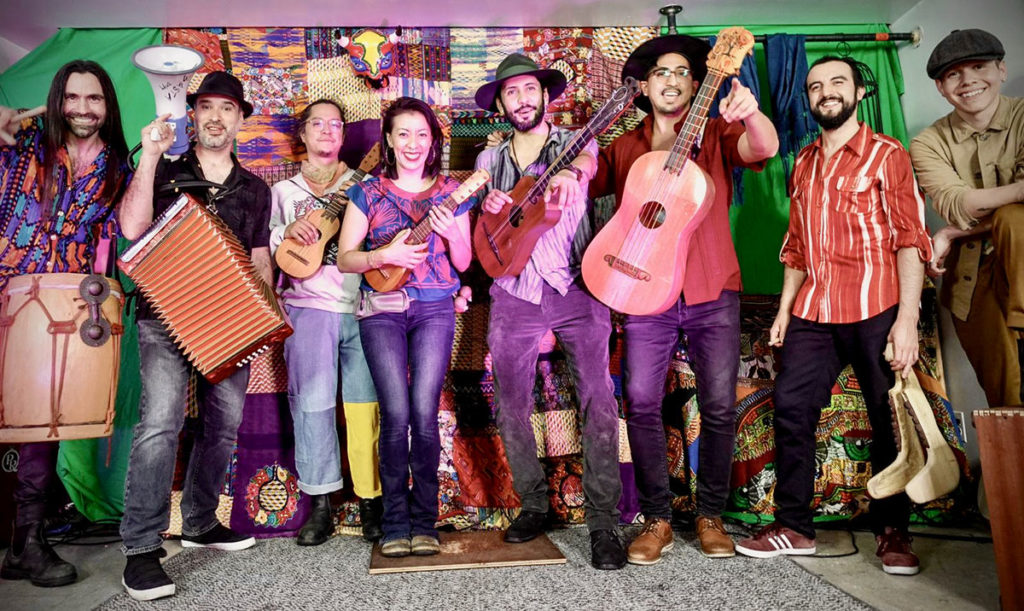Jarana Beat is an urban folk music collective that has been building fandango communities in New York City and around the world since 2007. This February 19, 2021 story has been updated since.
The Bronx’s own Jarana Beat does the Mexican Fandango at Terraza 7 in Elmhurst, Queens on Fri, May 13 at 10pm. $15. 🇲🇽
Jarana Beat
- Urban folk music collective recreating Mexican Afro-AmerIndian traditions in New York City and around the world
- Builds family-oriented, music-centric communities
- New York Fandango out of the South Bronx
Sinuhé Padilla-Isunza
The collective is led by music producer Sinuhé Padilla-Isunza 🇲🇽. It’s impossible to have a short conversation with him. He is an incredible musician who is somewhere between a musicologist and an anthropologist. When we talk, we end up traveling the world through music.
His studio is practically a museum of instruments. He’ll take one kind of guitar off the wall and play you a tune in two or three different styles. Then he’ll take another instrument down and do the same thing. He is really fun and fandango is really fun.
Jarana Beat’s fandango is based on the living traditions of Veracruz state, México where it is the voice of the people. The band preserves the traditions, but also updates them with modern themes. Jarana Beat is New York Fandango.
Jarana Beat Fandango
Jarana Beat was formed in 2007. The band’s debuted at NYU – New York University’s Hemispheric Institute of Performance and Politics Encuentro (meeting) in Buenos Aires, Argentina.
The group performs with a variety of traditional instruments including:
- Jaranas (a Veracruz type of guitar)
- Leonas (a Veracruz bass guitar)
- Tarimas (“the foot drum” wood platform to stomp and dance)
- Ayoyote shells (Aztec jingle shells)
- Donkey Jawbones (An African instrument popular in Latin America)
The band includes two dancers because without dancing, it’s not a fandango. Jarana Beat performances always have two parts. When the show finishes, the fandango starts.
Jarana Beat has performed at SXSW in Austin, Texas; Smithsonian Institute’s Folklife Festival, New York Symphony Space, Philadelphia’s Kimmel Center, and stages all over the world in Mexico, Argentina, Canada and Spain.
The band has been featured on NPR, Univision, and NY1 Noticias. They have won Mexican music awards and been officially recognized by the New York City government.
Jarana Beat are also teaching artists. They have taught at Berkeley College (which produces world-class jazz musicians), New Mexico State University, and CUNY Graduate Center (City University of New York).
Most of all Jarana Beat is fun because the fandango is fun.
The Fandango
Fandango is a Bantu (Central African) compound word that basically means a party of common folk. When work is done, we get together to talk and flirt and eat and drink with friends and family with drumming, singing and dancing for entertainment.
People do pretty much the same thing everywhere. It’s like going to dinner and a show in New York City, but in fandango you don’t just watch the show, you are part it.
This African tradition was popular in 1700s Spain, Portugal and southern France. There it mixed with Spanish and even Sephardi (Iberian Jewish) traditions. When Spanish human slavers brought Africans to the Americas, the traditions blended together with elements of the local people – Indigenous Americans.
There used to be fandangos from Mexico to Brazil. Today the fandango tradition lives on in Veracruz state, México, on the Gulf of Mexico coast.
The fandango has reached New York City too. Latin jazz, salsa, hip-hop and reggaeton all came out of the South Bronx. The fandango is the latest in this South Bronx Latin parade, “un desfile de melaza en flor.” (A parade of molasses in flower. “Las Caras Lindas” by Catalino “Tite” Curet Alonso, sung by Ismael Rivera.)
Let’s Break it Down

Fandango is not European, African, AmerIndian, or Mexican, but a blend of everyone, like Mexico and New York.
The guitars are a Spanish heritage, but they are played in a percussive way. They also play off each other in syncopation which creates polyrhythms. That’s Africa. It’s like a salsa of guitars.
In Mexican colonial times, the African drum was not allowed, so the people of Veracruz made time by stomping their feet on a piece of wood. That’s the “Zapateado” (sort of a tap dance) now a pan-Mexican tradition. We are not drumming, just stomping. How clever!
The mirroring of West African call and response is a community principle. If you call into the Fandango, someone will respond. It feels so good to know that you are not alone.
New York City needs this now.
“La Bamba” is a Fandango
Fandango is one of the roots of Latin rock and Latin alternative.
Many Americans of the United States know the song “La Bamba.” This early rock and roll hit for Ritchie Valens in 1958, was one of the first Spanish-language rock songs to gain international attention. In Mexico, this music evolved into Latin rock. In the U.S, it evolved into Latin alternative.
It turns out that “La Bamba” is a Mexican folk song from Veracruz. It was a fandango sung by Kongo musicians (modern Angola) in the Veracruz region as early as 1683 (Henry Louis Gates Jr., “Black in Latin America” documentary, 2011).
In Mexico, “La Bamba” was a traditional wedding song in which couples expressed their union through the unity of their dance. They danced together and became one. ¡Fandango!
Vibracíon por Simpatía (Sympathetic Vibrations)
First of all “sympathetic vibrations” occur when a tone matches the natural tone of a string or a box or a room. When you are singing in the shower and one note sounds much louder, you have found the natural frequency of the shower. The louder sound is a sympathetic vibration.
Fandango’s call-and-response between people is another form of sympathetic vibration. So is the syncopation of the guitars and the matching patterns of stomping feet. Basically a good fandango creates a strong sympathetic vibration.
“Vibracíon por Simpatía” (Sympathetic Vibration) is Jarana Beat’s triple album with a beautifully illustrated, 60-page, companion teaching book. They are fundraising on kickstarter.com to raise money to publish the book.
The album documents seven years of New York Fandango in the South Bronx with the contributions of over 55 artists. Several of them are Grammy winners. The book explains the music and the culture with lyrics and chord charts for every song. There are illustrations by renowned Colombian artist Tobías Arboleda. The book is designed by Mexican designer Martin Rodríguez.
This is an important document. This album should be in every school across the United States and in the Library of Congress. Fandango brings people together and our country needs this right now.
Vibración Por Simpatía Guest Artists
- Ana Tijoux 🇨🇱
- John Benitez 🇵🇷
- Laura Rebolloso 🇲🇽
- Andres Flóres 🇲🇽
- Alexis Díaz Pimienta 🇨🇺
- Mariana Carrizo 🇦🇷
- Rubí Oseguera 🇲🇽
- Mireya Ramos 🇲🇽 Flor de Toloache
- Shae Fiol 🇲🇽 Flor de Toloache
- Juan Gutierrez 🇵🇷
- Nelson Matthew Gonzalez 🇵🇷
- Julia Gutierrez 🇵🇷 Los Pleneros de la 21
- Benito Cortes Padua 🇲🇽
- Joel Cruz Catellanos 🇲🇽Los Cojolites
- Raquel Palacios Vega 🇲🇽 Los Vega
- Claudio Naranjos 🇲🇽 Los Vega
- Alex Colón-Olaniyan 🇧🇿
- James Lovell 🇧🇿 Garifuna Music
- Violeta Romero 🇲🇽 Caña Dulce Caña Brava
- Fernando Guadarrama 🇲🇽
- Frino 🇲🇽
- Hadar Noiberg 🇮🇱
- Gian Carla Tirsa 🇧🇴
- Sonia Olla 🇪🇸
- Ismael Fernandez 🇪🇸
- Sonia de los Santos 🇲🇽
- Nate Rojas 🇲🇽
- Diego Obregon 🇨🇴
- Yinon Muallen 🇮🇱🇹🇷
- Peter Bogados 🇺🇸/🇬🇷
- Chatrán González 🇲🇽
- Gregorio Uribe 🇨🇴
- Martín Vejarano 🇨🇴
- Eudi Guara 🇨🇺
- Dadier Aguilera 🇨🇺🇧🇷
¡Do the Fandango!
From Editor Keith Widyolar: I didn’t even know what the fandango was until I met Jarana Beat. The community of fandango is something New York City really needs right now. It’s the perfect antidote to the COVID Blues. We support Jarana Beat and hope you will too.
¡Fandango!
Jarana Beat Members

- Lautaro Burgos, percussion
- George Saenz, accordion, trombone, jarana
- Iva Contreras, jaranas
- Argelia Arreola, zapateado, jarana
- Sinuhé Padilla, jarana
- Víctor Murillo, requinto jarocho
- Felipe Fournier, percussion
- Martín Rodríguez, zapateado, quijada de burro
Previously
Jarana Beat does the Mexican Fandango at Terraza 7 in Elmhurst, Queens on Fri, Mar 11 at 8pm. $15. 🇲🇽
